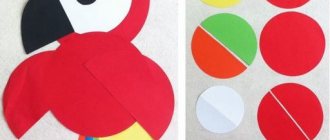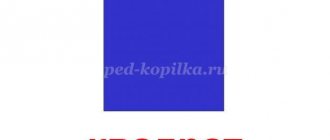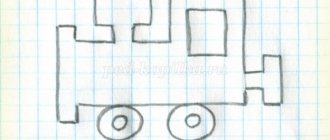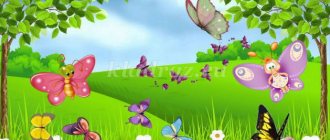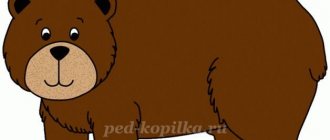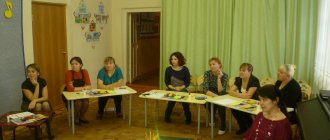Summary of GCD in the preparatory group in mathematics. Geometric figures
Abstract of the educational activity "An entertaining journey to the land of Mathematics" in the preparatory group.
Author: Olga Vyacheslavovna Varlamova, teacher of MKDOU “Gavrilovo-Posad kindergarten No. 1” Description: the lesson was built taking into account the Federal State Educational Standard, using game technology and active learning methods. Goal: Generalization of acquired knowledge. Program content: Training objectives: - to develop computing skills; - exercise children in forward and backward counting within 10; - practice establishing equality between numbers; - consolidate the ability to distinguish and correctly name geometric shapes. Developmental tasks: - create conditions for the development of logical thinking, intelligence, attention; - develop imagination, ingenuity, visual memory; - contribute to the formation of mental operations, speech development, and the ability to argue one’s statements. Educational objectives: - to cultivate interest in mathematical knowledge; - develop the ability to understand a learning task and carry it out independently. Demonstration material: balloon, letter, letters, names of stations, geometric shapes. Handouts: cards with numbers, squared pieces of paper, pens. Methodical techniques: - game (surprise moment); - verbal (reading a letter, questions, conversation, logical tasks); — visual (demonstration material); - lesson analysis, encouragement. GCD move: A ball with a letter flies into the group. The children notice the ball and gather around it. Educator: Guys, where did this ball come from? Who could give us such a surprise? (During the discussion we find out that the postman brought it). -Let's see what kind of letter this is, maybe we'll learn something interesting from it. (I unfold the letter) - It was written by a Fairy from the country of “Mathematics”.
Guys, who can read here? (I ask a child who can read to read the letter). “Dear guys, I invite you to go on a trip to the land of Mathematics, where I have prepared various tasks for you. You will need to add, subtract, compare, solve fun problems, think and reflect. For each completed task you will receive a letter. Then make a word from these letters. These tasks are for smart and resourceful children! Fairy from the Land of Mathematics." Educator: Guys, do you agree to go on a trip? Aren't you afraid of difficulties? Do you love to travel? What do you think you can travel with? (children's answers). - I like to travel too! We'll go by train.
What do you need to buy for a train trip? (tickets) - Dear passengers! Take your tickets and take your seats in the carriages. Have you noticed that the tickets are unusual? How do you know what your place is? (tickets are cards with written examples of addition and subtraction, and on the chairs are cards with answers). - Certainly. An example needs to be solved. (Children solve examples and find their places. Children who find it difficult are helped by other children). - Guys, look at each other, are you in the right place? But before our train sets off on its journey, let's remember: - how many days are there in a week? - name them; — what day of the week is it today? - what number is he? - What day of the week was yesterday? - What day of the week will it be tomorrow? - Well done! Go! The song “We are going, going, going to distant lands” is playing
- Attention!
Attention! Stop! Guys, let's read the name of the station? (children read) “Warm-up” Game: “Question and answer.” Questions: - serial counting up to 10; - count down from 10; - counting from 1 to 10; - counting from 4 to 9, from 7 to 2, from 9 to 3; - name the neighbors of the numbers 5, 3, 6, 8; - name the previous number of numbers 8, 2, 6; - name the next number of numbers 3, 5, 7. - You completed the task, you get a letter. What letter is this? (children's answers). - That's right, the letter M. Let's continue our journey! Take your seats! Go! The song “We are going, going, going to distant lands” sounds
- We have arrived!
Let's read the name of the station. (Children read). "Counting". Fill in the blanks by inserting the missing character or number. 3+5 8, 8 1=7, 2 2=4, 7 2=5, 10-3 7, 4+4 8, 6 4 10, 4 3 1. You did a great job with this task too! Get a letter! What letter is this? (children's answers). – That’s right, letter O. Let’s continue our journey! Take your seats! Go! A song is playing.
- We've arrived!
What kind of station is this? (Children read). "Geometric". Logical problem “Which figure is the odd one in the row?” You did a good job with this task too! Here's a letter for you! (Children name the letter) - That's right, the letter L. And our journey continues! Take your seats! Go! A song plays and the children sing along.
- We've arrived!
What kind of station is this? (Children read). "Jokes are riddles." Task "Logic puzzles". Be careful and you will definitely cope with them. 1. How many ears do three mice have? (6) 2. How many paws do two bear cubs have? (8) 3. What is lighter than 1 kg of cotton wool or 1 kg of honey? (weight is the same) 4. Two willows grew, on each willow there were two branches, on each branch there were two pears. How many pears are there in total? (Not at all. Pears don’t grow on willows). “You did a good job, here’s your letter.” (Children name the letter). Letter O. Now you can relax. Physical education minute. We've done some work, guys, and now let's all get exercise! Now we will all get up together, we will rest at the rest stop. Turn left, turn right, bend over, rise up. Hands up and hands to the side, And jump and jump on the spot! And now let’s skip and run, Well done, kids! Let's slow down, children, and stand still! Like this! And now we will sit down together, We still need to work. - Take your seats on the train! Go! A song is playing.
- We've arrived!
What kind of station is this? (Children read). “Take a guess.” Compare the numbers and put the appropriate equal or inequality sign. 2 5, 4 4, 3 1, 7 7, 9 10, 5 5, 8 6. Place cards with numbers in pairs so that the sum of each pair results in the number 10. 1 and 9, 2 and 8, 3 and 7, 4 and 6, 5 and 5, 6 and 4, 7 and 3, 8 and 2, 9 and 1. - For a completed task you receive a letter. What letter is this? (D) Take your seats on the train! Let's move on! A song is playing.
- We've arrived!
What kind of station is this? (Children read). "Graphic". Here we will do a mathematical dictation. From the point to the right 2 cells, Up 1 cell, Right 1 cell, Up 1 cell, Right 1 cell, Down 4 cells, Right 3 cells, Up 1 cell, Right 1 cell, Down 5 cells, Left 2 cells, Up 1 cell, Left 2 cells, Down 1 cell, Left 2 cells, Up 4 cells, Left 2 cells, Up 2 cells. - What did we do? (Dog) . For completing a task you receive a letter. What letter is this? (C) Take your seats on the train! Let's move on! A song is playing.
- We've arrived!
What kind of station is this? (Children read). "The ultimate." Solve the rebus: 4 3 2 5 1 T R A A P Having guessed the word PARTA correctly, children receive the letter Y. - Guys, you completed all the tasks! For each task you received letters. Let's read what kind of word we got. - Well, it’s time for us to return. Take your seats on the train. A song plays and the children sing along.
Educator: Guys, here we are in kindergarten. Did you enjoy our trip? Were the tasks difficult? Would you still like to travel to the land of Mathematics? (children's answers) And for good knowledge, the Fairy of the Country of Mathematics left you a gift, medals. Presentation of medals. Thank you for your attention!
We recommend watching:
Abstract of GCD in mathematics in the preparatory group. Counting to 20 Summary of direct educational activities in mathematics for children preparatory to school. Notes of GCD on FEMP in kindergarten. Preparatory group Math lesson in kindergarten. Preparatory group
Similar articles:
Summary of mathematics lessons in the preparatory group. Pentagon
Abstract of GCD in mathematics in the preparatory group. Solving logical problems
Abstract of GCD in mathematics in the preparatory group on the topic: Area
Abstract of GCD in mathematics in the preparatory group. Tangram
Abstract of GCD in mathematics in the preparatory group. Ruler, clock dial
At what age can you start learning geometric shapes?
A child’s knowledge of the world around him begins with his perception of objects and phenomena. At a very young age, children are not yet able to understand the shape of an object separately from itself. In fact, they experience them using various senses: not only by sight, but also by touch, as well as by pronouncing various words.
Study Kit
For your information! Comparison plays an important role in this process. Having seen a new object, the baby can determine whether it is similar to others already known to him.
In the process of development, a child perceives the geometric shape of objects differently. Small children see and feel them as a whole, without highlighting the shape. That is, each ball is not a ball for them, but a special object.
At an older age, the baby can already compare objects, determining their similarity or difference. Gradually he learns to properly highlight the elements of the form. In older preschool age, he already understands what a geometric figure is and what properties it has.
However, the development of geometric perception and thinking does not occur automatically, but through the learning process.
It is important to note that obtaining initial geometric knowledge and learning to count is for informational purposes only. At the same time, there is no systematic study of geometric knowledge. No precise definitions are considered at this time.
Important! In the process of studying, children learn to recognize and study figures, draw them, and describe them in Russian.
Purpose of the lesson
Fix the names of geometric shapes: “triangle”, “square”, “rectangle”, “quadrangle”; learn to classify figures according to different criteria: size, color, shape; practice counting within 10; learn to name a word that is opposite in meaning to the one suggested.
Materials
For the teacher: ball.
For children: a set of geometric shapes of different colors, sizes, shapes (20 pcs.).
Progress of the lesson
Sitting at the table
There are geometric shapes on the tables in front of the children. The teacher asks the children to name them and gives tasks.
Set aside all the circles. What are they in size and color?
Set aside the green pieces. What shape are they? How many are there?
Set aside the quadrangles. Call them differently. Tell me, how many different quadrilaterals are there?
Set aside all the shapes except the triangles. What shape are they?
Set aside the yellow little shapes. What shape are they? Let's play
Games can be played both indoors and on the site.
"Count on"
Children form a circle. The teacher stands in the center of the circle. He's bro-
throws a ball to one of the children and calls any number. The child who catches the ball calls the next 2-3 numbers and returns the ball to the teacher. Now the teacher throws the ball to another child and the game continues.
A variation of the game could be the “Before and After” game. The teacher throws the ball to the child and says: “Count to five.” The child must name the numbers that go up to five: one, two, three, four.
If the teacher says: “After five,” the children must name the numbers: six, seven, eight... The game takes place at a fast pace.
"Vice versa"
The game takes place in a circle. The teacher stands in the center of the circle, throws the ball to one of the children and says the word. The child must say a word that has the opposite meaning. The teacher says: “Forward.” The child answers: “Back.” (Right - left, up - down, far - close, inside - outside, etc.)
Making the game more difficult. You can name not only adverbs, but also adjectives: far - close, upper - lower, right - left, deep - shallow, cheap - expensive, etc.
If the child finds it difficult to answer, the children say the right word in unison.
On a walk
Draw children's attention to the changes that occur in nature in autumn. Find out what time of year and month it is. Ask what month September is (ninth), ask the children to name all the months.
Remind us of the proverbs about autumn.
tt In September there is one berry, and even that bitter rowan.
te September is cold, but full.
tit In September, summer ends and autumn begins.
Tips for a teacher
Don’t forget to tear off a piece of the calendar for the past day every morning with your children. Ask your children what day of the week it was yesterday and what day it is today. Invite the children to name today's date and month. Think back to the summer months.
At the beginning of the school year, it is necessary to conduct an individual interview with each child within two weeks. The purpose of the interview is to identify children’s knowledge, skills and abilities in mathematics. Enter the results of the interview in the table. The contents of the interview and the methodology are given at the end of the book.
Tell parents that over the next two weeks, conversations will be held with children that will reveal their mathematical understanding and ability to operate with them.
